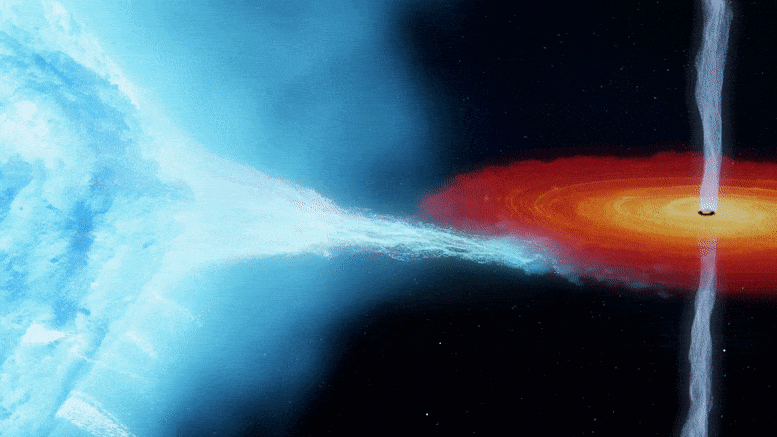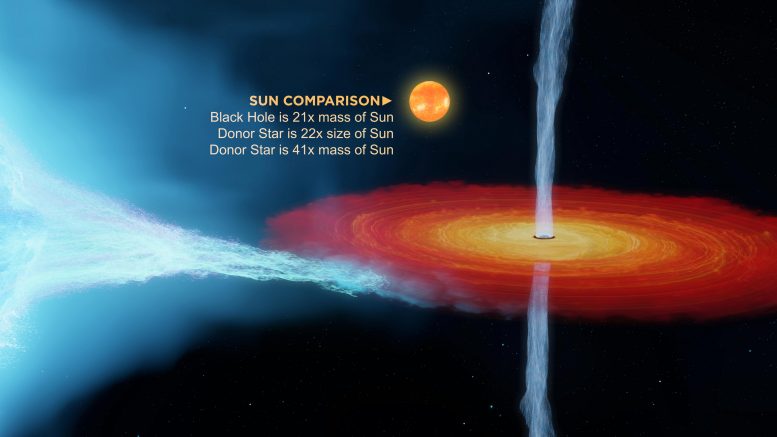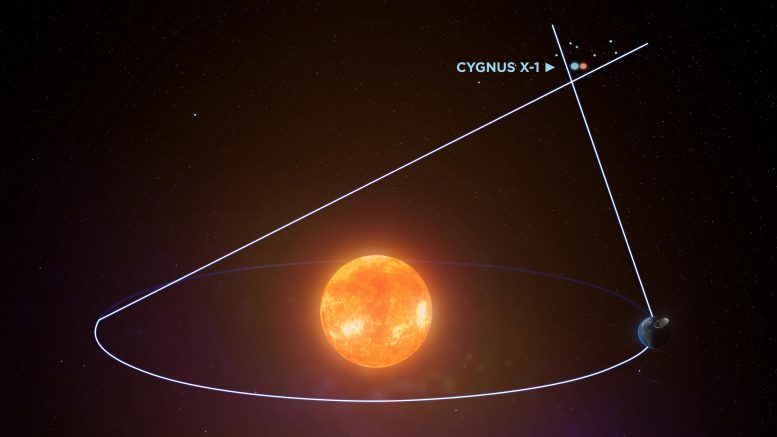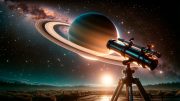
Researchers found that the stellar-mass black hole within the Cygnus X-1 binary system possesses a mass 21 times that of the Sun and rotates at a speed approaching the speed of light.
Cygnus X-1, a binary star system first discovered in 1964, comprises one of the closest black holes to Earth. New observations of this black hole, the first ever detected, have led astronomers to question what they know about the Universe’s most mysterious objects.
An international team, including researchers from the National Astronomical Observatories of the Chinese Academy of Sciences (NAOC), recently found that the stellar-mass black hole in the Cygnus X-1 binary system has a mass 21 times the mass of the Sun and rotates at a speed close to the speed of light.
The study was published in Science on February 18, 2021.

Recent observations show the black hole in the Cygnus X-1 system is 21 times the mass of the Sun—a 50 per cent increase on previous estimates. To form such a massive black hole, astronomers had to revise their estimates of how much mass stars lose via stellar winds. Credit: International Centre for Radio Astronomy Research
The researchers used the Very Long Baseline Array — a continent-sized radio telescope made up of 10 dishes spread across the United States — together with a clever technique to measure distances in space.
“If we can view the same object from different locations, we can calculate its distance away from us by measuring how far the object appears to move relative to the background,” said Prof. James Miller-Jones, a researcher at Australia’s Curtin University and the International Centre for Radio Astronomy Research (ICRAR), who is first author of the study.
“If you hold your finger out in front of your eyes and view it with one eye at a time, you’ll notice your finger appears to jump from one spot to another. It’s exactly the same principle,” said Prof. Miller-Jones.
An animation showing the Cygnus X-1 system, consisting of a black hole in orbit with a giant star. Recent observations by radio telescopes have found the system is 20 percent further away than previously thought, implying the black hole is 21 times the mass of the Sun, making it the most massive stellar-mass black hole ever detected without the use of gravitational waves. Credit: International Centre for Radio Astronomy Research
Over six days, the researchers observed a full orbit of the black hole around its companion blue supergiant variable star. They then compared the new data with observations of the same system taken with the same telescope array in 2011. Their new observations and measurements showed that the system is further away than previously thought.
With this new distance information, the researchers re-estimated the mass of the Cygnus X-1 black hole and found it to be more than 20 times the mass of our Sun — a 50 percent increase over previous estimates.
Prof. GOU Lijun of NAOC is a co-author of the study and led the study’s spin measurement.

Astronomers observed the Cygnus X-1 system from different angles using the orbit of the Earth around the Sun to measure the perceived movement of the system against the background stars. This allowed them to refine the distance to the system and therefore the mass of the black hole. Credit: International Centre for Radio Astronomy Research
“Using the updated measurements for the black hole’s mass and its distance away from Earth, we were able to confirm that Cygnus X-1 is spinning incredibly quickly — very close to the speed of light and faster than any other black hole found to date,” said Prof. GOU.
Co-author Prof. Ilya Mandel, a scientist from Australia’s Monash University and the ARC Centre of Excellence in Gravitational Wave Discovery (OzGrav), said the black hole is so massive and rotating so fast that it is actually challenging astronomers’ thoughts on how black holes formed.
“Stars lose mass to their surrounding environment through stellar winds that blow away from their surface. But to make a black hole this heavy and rotating so quickly, we need to dial down the amount of mass that bright stars lose during their lifetimes,” he said.
The black hole in the Cygnus X-1 system began life as a star approximately 60 times the mass of the Sun and collapsed tens of thousands of years ago. Incredibly, it’s orbiting its companion star every five-and-a-half days at just one-fifth the distance between the Earth and the Sun.
Accompanying the publication in Science, two further papers focusing on different aspects of this work have also been published today in The Astrophysical Journal.
Read First Black Hole Ever Detected – Cygnus X-1 – Is Much More Massive Than We Thought for more on this research.
References:
“Cygnus X-1 contains a 21-solar mass black hole – implications for massive star winds” by James C. A. Miller-Jones, Arash Bahramian, Jerome A. Orosz, Ilya Mandel, Lijun Gou, Thomas J. Maccarone, Coenraad J. Neijssel, Xueshan Zhao, Janusz Ziólkowski, Mark J. Reid, Phil Uttley, Xueying Zheng, Do-Young Byun, Richard Dodson, Victoria Grinberg, Taehyun Jung, Jeong-Sook Kim, Benito Marcote, Sera Markoff, María J. Rioja, Anthony P. Rushton, David M. Russell, Gregory R. Sivakoff, Alexandra J. Tetarenko, Valeriu Tudose and Joern Wilms, 18 February 2021, Science.
DOI: 10.1126/science.abb3363
“Reestimating the Spin Parameter of the Black Hole in Cygnus X-1” by Xueshan Zhao, Lijun Gou, Yanting Dong, Xueying Zheng, James F. Steiner, James C.A. Miller-Jones, Arash Bahramian, Jerome A. Orosz and Ye Feng, 18 February 2021, The Astrophysical Journal.
DOI: 10.3847/1538-4357/abbcd6
arXiv: 2102.09093
“Wind mass-loss rates of stripped stars inferred from Cygnus X-1” by Coenraad J. Neijssel, Serena Vinciguerra, Alejandro Vigna-Gomez, Ryosuke Hirai, James C. A. Miller-Jones, Arash Bahramian, Thomas J. Maccarone and Ilya Mandel, 18 February 2021, The Astrophysical Journal.
DOI: 10.3847/1538-4357/abde4a
arXiv: 2102.09092









Be the first to comment on "New Observations of First Black Hole Ever Detected Leads to Questions About the Universe’s Most Mysterious Objects"